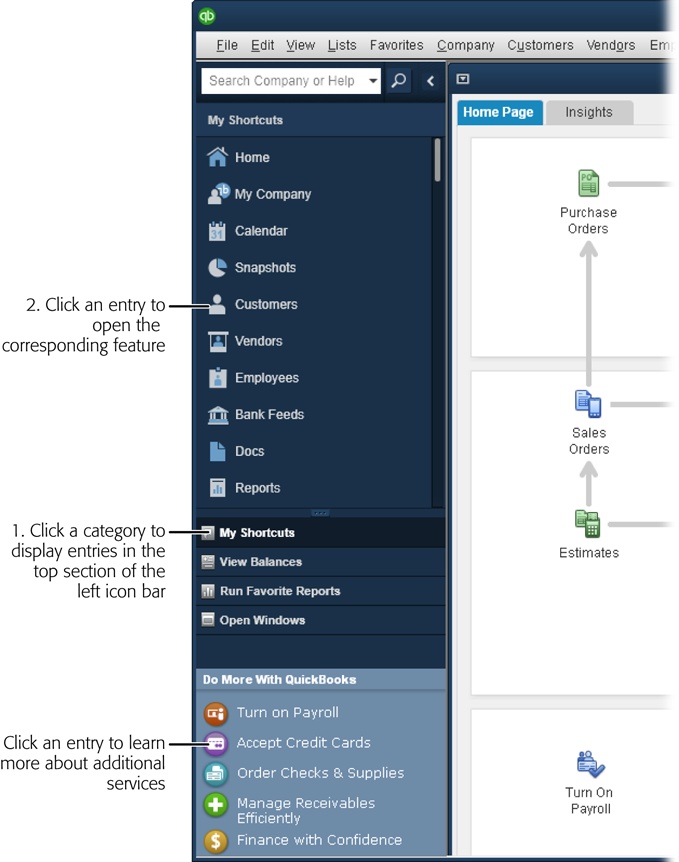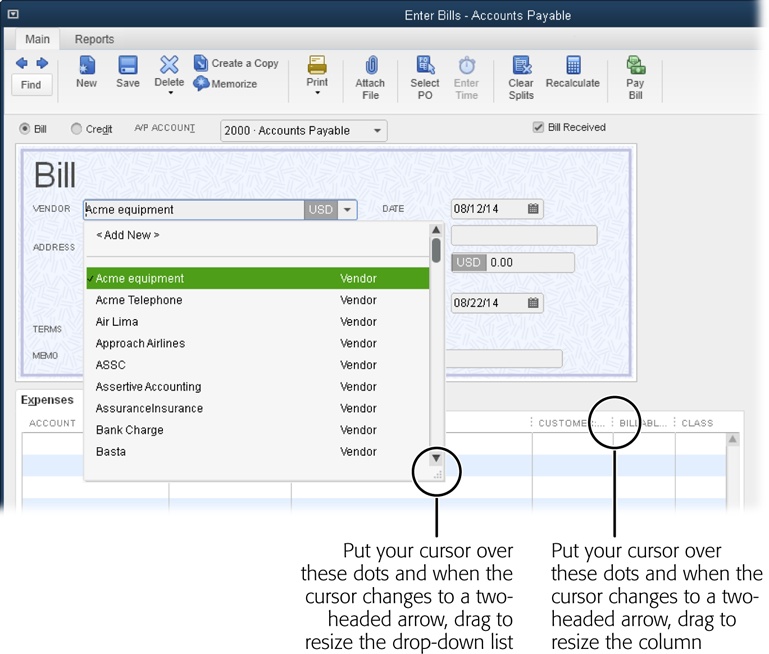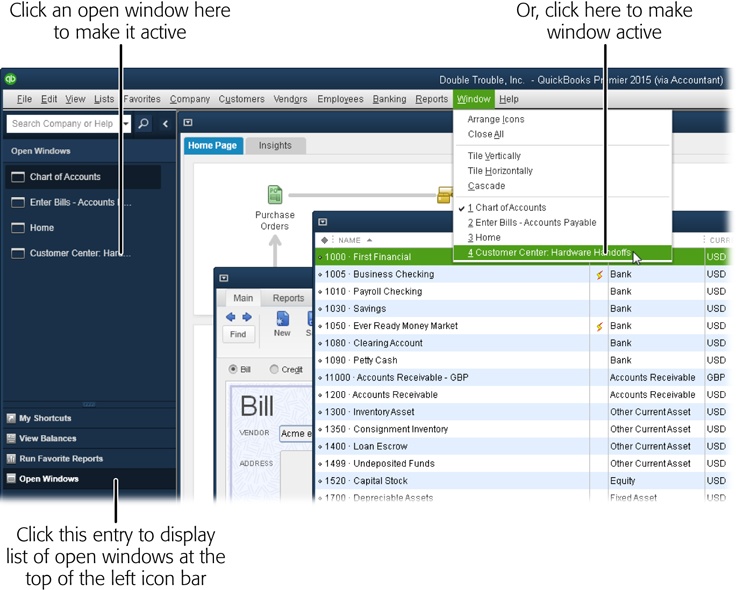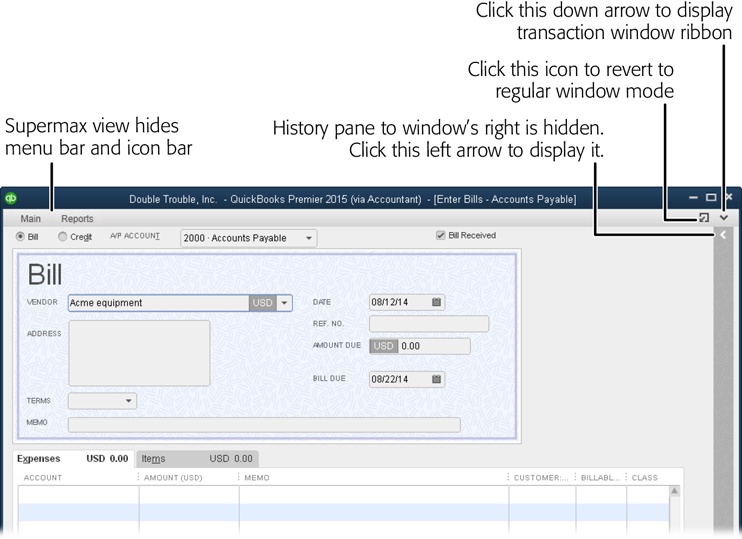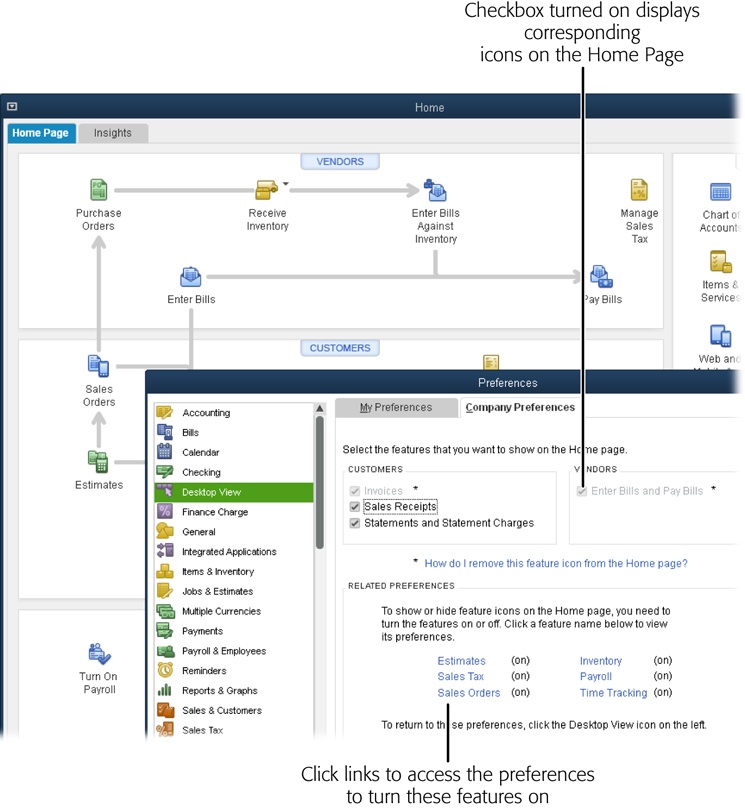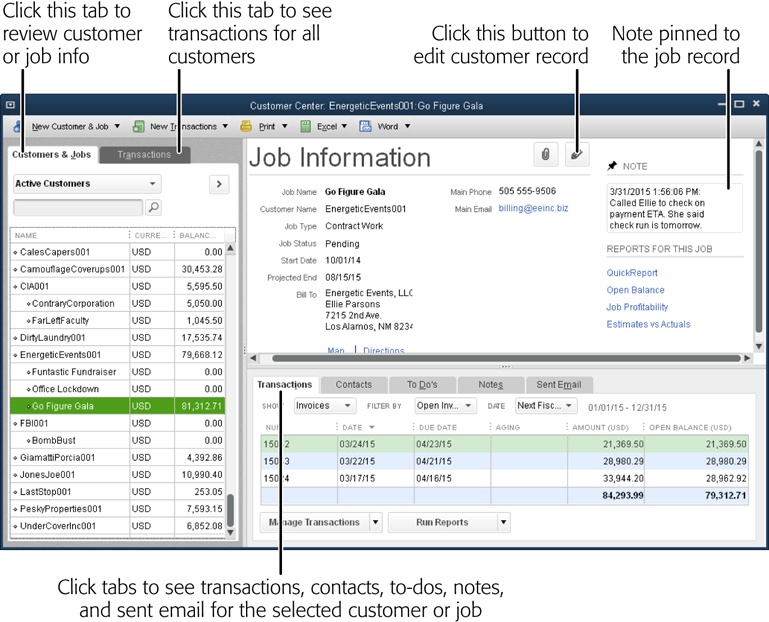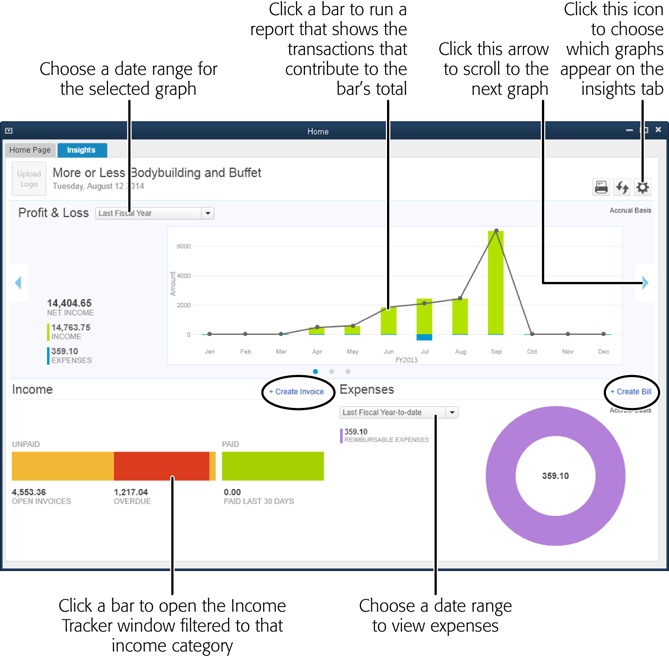You have more than enough to do running your business, so you don’t want bookkeeping to take any more time than necessary. QuickBooks’ icon bar (which comes in two flavors: left and top) offers shortcuts to your favorite features. Each version of the icon bar has its pros and cons, so you have to decide which one you prefer (or you can hide them). This chapter shows you how to access QuickBooks’ features from both the menu bar and icon bars.
During a rousing bookkeeping session, you might end up with several QuickBooks windows open at the same time. In this chapter, you learn how to work with all the windows you open. For example, if you prefer to focus on one task, you can tell QuickBooks to display only one window at a time.
Another way to get your accounting done quickly and efficiently is by accessing features via the QuickBooks Home Page. This page not only provides a visual roadmap of the bookkeeping tasks you perform regularly, but it also gives you quick access to tasks and information related to vendors, customers, and employees, along with the features and overall financial info you use most often. Click an icon, and the corresponding window or dialog box appears, such as Chart of Accounts, Item List, Write Checks, or everyone’s favorite—Make Deposits.
This chapter explains how to use the workflow icons on the Home Page, as well as the Vendor, Customer, and Employees Centers that open when you click the corresponding buttons in the Home Page’s panels. (The Inventory Center, which is available in QuickBooks Premier and Enterprise, is described on Viewing One Inventory Item.) You’ll also see how to review your company’s finances in the Company Snapshot window and the Home window’s new Insights tab.
The menu bar at the very top of the QuickBooks window (Figure 2-1) is a convenient way to launch different activities. It’s handy because it’s always visible and serves up every feature the program has to offer.
Figure 2-1. Every feature in QuickBooks is always within reach via the menu bar. Choose a top-level menu like Customers (as shown here), and then choose an entry from the drop-down menu or a submenu. For one-click access to your favorite features, use the left icon bar (visible here) or top icon bar, both of which you can customize to include the features and reports you use the most (page 700).
You can use the View menu to choose between two versions of the icon bar: top and left. The top icon bar (View→Top Icon Bar) has been around for years. If you haven’t graduated to a large, widescreen monitor, this icon bar is both convenient and space-saving. (If you really need more space, you can hide the icon bar by choosing View→Hide Icon Bar.) It sits just below the menu bar and displays your favorite features as icons with brief identifying labels. Click an icon, such as Home, Calendar, or Bill, and the corresponding feature launches.
The left icon bar (View→Left Icon Bar), shown in Figure 2-2, appears the first time you launch QuickBooks 2015. The categories in the middle section of this icon bar determine what’s displayed in its top section. Here’s what the entries in the middle section of the left icon bar do:
My Shortcuts. This category, which appears at the top of the left icon bar whenever you launch QuickBooks, is a great way to keep your favorite features within easy reach. Out of the box, this category includes features that most people use frequently. But you can add other features you use all the time and get rid of shortcuts you don’t use simply by right-clicking anywhere within the My Shortcuts section (except on the My Shortcuts heading), and then clicking Customize Shortcuts.
Figure 2-2. The left icon bar includes three sections that help you access your favorite features. The unlabeled middle section contains categories like My Shortcuts and View Balances. When you click an option in this section, the top section displays the entries for that category, like the shortcuts shown here. The bottom section contains links to other products and services that Intuit offers, such as payroll and merchant credit card services.
View Balances. When you use the left icon bar, the Home Page doesn’t display account balances on its right side as it does when you use the top icon bar. To see your account balances at the top of the left icon bar, click this category. (Account Balances explains how to customize which account balances you see.)
Run Favorite Reports. Clicking this category lists the reports that you’ve flagged as your favorites (Finding Frequently Used Reports). The reports you see are the same ones that appear when you choose Reports→Favorite Reports or display the Report Center’s Favorites tab.
Open Windows. If you turn on the preference to use multiple windows (Desktop View), you can click this category to see a list of open windows at the top of the left icon bar. Click a window’s name to make it active. This category displays the same windows you see if you choose View→Open Window List when using the top icon bar.
Tip
The left icon bar takes up a couple of inches on the left side of the main QuickBooks window, so it’s more useful if you have a widescreen monitor. With older and smaller monitors, you’ll have trouble fitting the left icon bar and your transaction windows onscreen at the same time. In that case, the menu bar, top icon bar, and Home Page (which you’ll learn about in a sec) are ready to assist you.
After shortcut menus (which you display by right-clicking things) and keyboard shortcuts (which you can read about in online Appendix C, available at www.missingmanuals.com/cds), the icon bar is the fastest way to launch your favorite features. As Fast Access to Favorite Features explains, you can customize the icon bar to add features, memorized reports, and windows you open often—and remove features you don’t use.
Throughout QuickBooks, you can resize drop-down lists to change their heights and widths. This comes in handy, for example, when you want to see your customers’ full names in a Customer:Job List drop-down list or view more accounts in an account drop-down list so you don’t have to scroll as much to locate the account you want. You can also resize columns in transaction windows’ tables so you can read more of those columns’ contents. For example, you might widen the Memo column on the Enter Bills window’s Expenses tab while narrowing the Amount column.
Here’s what you do:
To resize a drop-down list, open it, and then put your cursor over the dots in the list’s lower-right corner (circled in Figure 2-3). When the cursor changes to a two-headed arrow, drag to adjust the list’s width and height.
To change the widths of columns in a table, place your cursor over the vertical dots between two column headings (also circled in Figure 2-3), and then drag left or right to shrink or widen the column to the left.
Figure 2-3. Resizable drop-down lists include a triangle made of dots below their scrollbars (circled, left). When you put your cursor over these dots, it changes to a two-headed arrow, which is your cue that you can drag to resize the drop-down list. The same technique works with the vertical dots between columns in a table (circled, right): Place your cursor over the dots, and then drag left or right to resize the column to the left.
If you tend to work on one bookkeeping task for hours on end, you can set QuickBooks up to display one full-size window at a time by choosing View→One Window. That way, when you open additional windows, they get stacked on top of one another so you see only the last one you opened.
If you go with the one-window approach, you have several ways to choose the window you want to see:
In the middle section of the left icon bar, click Open Windows as shown in Figure 2-4. Then, in the top section of the left icon bar, click the name of the window you want.
If you use the top icon bar, you can see a list of open windows by choosing View→Open Window List. Then, in the list, simply click the name of the window you want to work with.
On the menu bar, choose Window, and then choose the name of the one you want to see.
Figure 2-4. You can switch to another window by clicking the Window menu at the top of the screen and then choosing the window you want to display. When you have multiple windows open, the Window menu includes entries for arranging them, such as Cascade and Tile Vertically.
If, on the other hand, you flit between bookkeeping tasks like a honeybee in an alfalfa field, you probably want to display several windows at a time. QuickBooks can do that: just choose View→Multiple Windows.
Like windows in other programs, simply click a window to bring it to the front, or use the buttons in its upper right to minimize, maximize, or close it. You can reposition windows by dragging their title bars or resize them by dragging their edges and corners. If the window you want is hidden behind other windows, choose the one you want in the Open Windows List or from the Window menu on the menu bar.
When you want to see as much information as possible in a transaction window, such as Create Invoices, Supermax view, shown in Figure 2-5, is just the ticket. To switch a transaction window to Supermax mode, at the window’s top right, click the four-headed arrow.
Figure 2-5. Supermax view hides the menu bar, the icon bar, and the ribbon at the top of the transaction window. It also hides the transaction history panel on the window’s right side. You can restore or hide the ribbon and transaction history panel by clicking the appropriate icons at the window’s top right (labeled).
This view does several things so you can see more of the data-entry lines:
Hides the QuickBooks menu bar and (if you use it) the icon bar.
Minimizes the ribbon (which is similar to the ribbons in Microsoft programs) at the top of the transaction window.
Fills the entire QuickBooks window with the transaction window you Supermaxed.
Hides the transaction history panel on the window’s right side.
To revert to regular window mode, click the icon that looks like a square with an arrow pointing to its lower left (labeled in Figure 2-5). When you revert to regular window mode, the menu bar, icon bar, and feature panel at the top of the transaction window all reappear.
The QuickBooks Home Page (Figure 2-6, background) is a slick way to work through your company’s bookkeeping tasks in the right order. (If it isn’t visible, display it by choosing Company→Home Page or clicking Home in the left icon bar’s My Shortcuts section.) This section explains how to use the Home Page to best advantage.
Figure 2-6. If a feature you use doesn’t appear on the Home Page, choose Edit→Preferences→Desktop View, and then click the Company Preferences tab (foreground). For example, if you want to enter sales receipts, turn on the Sales Receipts checkbox, as shown here. Some features (like Estimates and Sales Tax) have their own section of preferences. At the bottom of the Company Preferences tab, the Related Preferences section includes links you can click to jump to the corresponding preferences.
The settings you chose when you created your company file determine what initially appears on the Home Page. Depending on your choices, you’ll see several panels—Vendors, Customers, Employees, Company, and Banking—that each contain various icons. For example, if you told QuickBooks that you invoice customers and send statements, the Customers panel includes icons for invoicing and preparing statements. Or if you run a one-person shop with no employees, you won’t see the Employees panel.
Note
In Figure 2-6, the Invoices and “Enter Bills and Pay Bills” checkboxes are grayed out. That’s because QuickBooks turns on some settings automatically based on other settings you chose. For example, if you turn on the estimates feature (as in Figure 2-6), the program automatically turns on invoices, because you can convert estimates you create into invoices.
The Home Page also has icons for other important features, like the Chart of Accounts icon in the Company panel, which opens the Chart of Accounts window, and the Check Register icon in the Banking panel, which opens an account register window for the bank account you select.
Tip
The Home Page appears each time you log into a company file. If you prefer to keep the Home Page hidden, choose Edit→Preferences→Desktop View, click the My Preferences tab, and then turn off the “Show Home page when opening a company file” checkbox. After that, when you want to see the Home Page, simply choose Company→Home Page.
Vendors, customers, and employees each have their own panel on the Home Page, and the various arrows show how bookkeeping tasks fit together so you can follow your money from start to finish. The bookkeeping tasks for each group are laid out like breadcrumbs you can follow. However, each company is different, so you don’t have to use every icon you see. This section outlines the tasks you can perform from each panel and where to find detailed instructions elsewhere in this book.
Whether you purchase products and services to run your company or to sell to your customers, the Home Page’s Vendors panel steps you through purchasing and paying for those goods and services; these steps are described in detail in Chapter 9.
The Vendor Center (Figure 2-7) is the best place to create, edit, and view what’s going on with your vendors and vendor-related transactions. To open it, click the Vendors button at the top of the Home Page’s Vendors panel or choose Vendors→Vendor Center. Here’s what you can do there:
Create a new vendor. In the Vendor Center toolbar at the top of the window, click New Vendor→New Vendor and the New Vendor window opens so you can create a new vendor record, as described on Creating a Vendor. If you click New Vendor→Add Multiple Vendors instead, QuickBooks lets you create several vendors in one window (Adding or Editing List Entries).
Find a vendor. If you have a bazillion vendors, you can shorten the vendor list that you see in the Vendors tab on the window’s left side. The tab’s unlabeled drop-down list is initially set to Active Vendors. If you want to see active and inactive vendors alike, click the field and choose All Vendors instead. If you’d rather see only the vendors you owe money to, choose “Vendors with Open Balances.” Choose Custom Filter to specify exactly the criteria you want.
To do a quick search of vendor records, type part of a vendor’s name in the Vendors tab’s second unlabeled box, and then click the Find button, which has a magnifying glass on it. (The Find button then changes to an X, which you can click to clear the value in the Find box and redisplay the full list.)
Review a vendor’s record. When you select a vendor on the Vendors tab, basic info about that vendor appears at the window’s top right, as shown in Figure 2-7.
Figure 2-7. The Vendor Center puts all vendor-related tasks in a single window. When you choose a vendor in the list on the left, the Vendor Information pane on the right displays info about that vendor. Click the Open Balance link (circled) to see the transactions that contribute to your balance with that vendor. You can even click the Map or Directions link to find out how to get to your vendor. And new in QuickBooks 2015, you can pin a note (page 481) you created in a vendor’s record so it appears at the Vendor Information pane’s top right, as shown here.
Edit an existing vendor’s record. To change a vendor’s record, on the Vendors tab, right-click the vendor’s name, and then choose Edit Vendor; or, on the right side of the Vendor Center, click the Edit button (its icon looks like a pencil tip). Either way, the Edit Vendor window opens with the same fields you filled in when you created the vendor’s record (Creating a Vendor).
Attach an electronic document to a vendor record. Printing in Batches explains how to add attachments to a vendor’s record.
Create transactions for a vendor. In the Vendor Center toolbar, click New Transactions to display a drop-down menu of vendor-related features like Enter Bills, Pay Bills, and Receive Items. (These do the same thing as the icons in the Home Page’s Vendors panel.) If you need to review and record several transactions for the same vendor, this drop-down menu is a real timesaver. After you select the vendor in the Vendors tab and then choose an entry on this drop-down menu, the corresponding transaction window opens with that vendor already selected.
Review and manage transactions, contacts, to-dos, notes, and emails for a vendor. When the Vendors tab is displayed, the bottom-right part of the Vendor Center displays tabs for transactions, contacts, to-dos, notes, and sent email. When you select a vendor in the Vendors tab, the Transactions tab at the bottom right of the Vendor Center lists that vendor’s transactions. By filtering these transactions, you can find out which purchase orders are still open, whether any bills are overdue, and what payments you’ve made. To see a specific kind of transaction, in the Show drop-down list, choose a type, like Bills or Bill Payments. The Filter By drop-down list lets you restrict the transactions in the table by their status, such as Open Bills or Overdue Bills. To track down transactions within a specific date range, choose an option from the Date drop-down list. (The options in this menu are the same as the ones available in report windows; see Choosing Date Ranges.)
Tip
To view a transaction in its corresponding window, double-click it in the Transactions tab’s table.
Click the Contacts, To Do’s, Notes, or Sent Email tab to create, edit, or view contacts, to-dos, notes, or sent email for the selected vendor.
Review transactions for all vendors. When you click the Transactions tab on the left side of the window (not the bottom right) and then click a type of transaction, such as Bills or Bill Payments, you’ll see transactions of that type for all vendors on the right side of the window. You can filter these transactions by status (such as open or overdue), by date, and, if you use multiple currencies, by currency.
Print or export vendor information. When you click the Vendors tab on the left side of the window, you can easily print, copy, import, or export vendor info. In the Vendor Center toolbar, click Print to print vendor lists, vendor info, or vendor transactions. Click Excel to paste, import, or export vendor info and transactions (Importing with the Excel Import Wizard Templates). If you click the Transactions tab on the left side of the window instead, you can print or export transactions.
Prepare vendor letters. When the Vendors tab on the left side of the window is selected, click Word in the Vendor Center toolbar to create letters to vendors (Mail Merge to a Word Document).
The Home Page’s Customers panel has icons for creating customer-oriented features like invoices, statements, sales receipts, and so on. (Chapter 10 describes how to work with invoices, estimates, sales orders, refunds, and customer credits. Chapter 11 covers creating statement charges and statements. And Chapter 13 explains how to receive payments and create sales receipts for cash sales.) Click the Customers button at the top of the panel (or choose Customers→Customer Center) to open the Customer Center (Figure 2-8), where you can perform the following tasks:
Create a new customer or job. In the Customer Center toolbar at the top of the window, click New Customer & Job. In the drop-down menu, choose New Customer to create a new customer record (Creating a New Customer), or choose Add Multiple Customer:Jobs to add several customers.
Add a job to an existing customer. Select the customer in the Customers & Jobs tab on the left side of the Customer Center, and then click New Customer & Job→Add Job (Creating a New Job).
Find a customer. You can filter the list in the Customers & Jobs tab to show active customers, only customers who owe you money (customers with open balances), and so on, simply by choosing an option in the tab’s unlabeled drop-down list (it’s initially set to Active Customers). Choose Custom Filter to specify criteria for the customers you want to see. To search for a specific customer, type part of the customer’s name in the tab’s second unlabeled box, and then click the Find button (it has a magnifying glass on it). The Find button then changes to an X, which you can click to clear the value in the Find box and redisplay the complete list.
Review a customer or job record. When you select a customer or job in the Customers & Jobs tab, the right side of the center displays the basic 411 about that customer or job. In the Customer Information (or Job Information) section, shown in Figure 2-8, you can get directions to its location, look at key information like the customer’s or job’s open balance, attach electronic documents to the record, or run reports about the customer or job.
Figure 2-8. To open or edit a customer’s or job’s record, in the Customers & Jobs tab, select the customer or job so it appears in the Customer Information (or Job Information) section, as shown here. To edit it, click the Edit button labeled here. To see more info about the selected customer or job, click the Transactions, Contacts, To Do’s, Notes, or Sent Email tabs at the bottom right of the window. To see transactions for all customers, click the Transactions tab on the left side of the window.
Review a customer’s or job’s status. Suppose you want to look at a bar graph of sales you’ve made to a customer by time period, review the items that customer buys the most, and then scan a customer’s recent invoices and payments. First, select the customer in the Customers & Jobs tab. Then, on the right side of the Customer Center, click the Customer Snapshot link to open the Company Snapshot window (The Company Snapshot) to the Customer tab.
Edit a customer or job. To open the Edit Customer or Edit Job window, in the Customers & Jobs tab, right-click a customer’s or job’s name, and then choose Edit Customer or Edit Job, respectively. Or select a customer or job, and then click the Edit button labeled in Figure 2-8.
Attach an electronic document to a customer’s or job’s record. You can add attachments to a customer’s or job’s record or scan images of them into QuickBooks, as described on Printing in Batches.
Create transactions for a customer or job. If you’re reviewing a customer’s or job’s transactions and realize you forgot to record an invoice or other transaction, you can easily create transactions right from the Customer Center window. Select the customer or job on the Customers & Jobs tab and then, in the window’s toolbar, click New Transactions and choose a transaction type from the drop-down menu, such as Estimates, Invoices, or Receive Payments. The items in this menu are the same as the icons in the Home Page’s Customers panel and open the corresponding window to record that type of transaction.
Review and manage transactions, contacts, to-dos, notes, and emails for a customer or job. When the Customers & Jobs tab is displayed on the left side of the window, the bottom right of the Customer Center includes tabs for transactions, contacts, to-dos, notes, and sent emails. If you click the Transactions tab at the bottom right of the window, you’ll see a table with the transactions for the customer or job you selected in the Customers & Jobs tab. You can filter these transactions by type (estimates or invoices, for example), status, and date. Double-click a transaction in the list to open a window with details about it. Click the Contacts, To Do’s, Notes, or Sent Email tabs to create, edit, or view contacts, to-dos, notes, or emails for the selected customer.
Review transactions for all customers. When you click the Transactions tab on the left side of the window and then click a type of transaction (such as Estimate, Invoices, or Received Payments), the right side of the window displays transactions of that type for all customers. Depending on the type you choose, you can filter these transactions by status (such as open or overdue), payment method, date, and—if you use multiple currencies—currency.
Print or export customer information. When you click the Customers & Jobs tab on the left side of the window, you can print, copy, import, or export customer info. In the center’s toolbar, click Print to print customer information (Sorting Lists) or click Excel to import or export customer and job info (Importing with the Excel Import Wizard Templates). If you click the Transactions tab on the left side of the window instead, you can print or export customer transactions.
Prepare customer letters. In the Customer Center toolbar, click Word to create letters to customers (Mail Merge to a Word Document).
The Home Page’s Employees panel has only a few icons. The devilish details arise when you click one of these icons to enter time, set up paychecks, or pay payroll tax liabilities. The Employee Center works the same way as the Vendor and Customer centers you just learned about. To open it, click the Employees button at the top of the panel on the Home Page or choose Employees→Employee Center.
In the Employee Center, you can create new records for employees, update info for existing employees, and view transactions like paychecks. On the Employees tab on the left side of the center, you can filter the list to view active employees, released employees (ones who no longer work for you), or all employees. See Chapter 8 to learn how to record the time that employees work. And online Appendix D (available at www.missingmanuals.com/cds) covers the process of paying employees and other payroll expenses.
The Company panel is on the right side of the Home Page. The two icons in this panel that you’ll probably click most often are Chart of Accounts and Items & Services, which open the Chart of Accounts (Creating an Account) and Item List (Creating Items) windows, respectively. Click Calendar to review transactions and to-dos in the Calendar window (Your Financial Calendar).
If you track inventory, click the Inventory Activities icon and then choose a feature, such as Adjust Quantity/Value On Hand, which lets you change the quantity and value of your inventory (Adjusting Inventory in QuickBooks). If you use QuickBooks Premier or Enterprise, click Inventory Center to open a window similar to the Customer Center except that it focuses on the status of—and transactions involving—your inventory items (Viewing One Inventory Item). If you’re interested in other apps and services that Intuit has to offer, click the “Web and Mobile Apps” icon, and a browser window opens to Intuit’s App Center.
The Home Page’s Banking panel is a one-stop shop for banking tasks. Whether you visit this panel frequently or rarely depends on how you like to record transactions. For example, you can click the Write Checks icon to open the Write Checks window (Paying Selected Bills) or simply press Ctrl+W to do the same thing. (Or, if you like to record checks in a check register window, you might prefer to click the Check Register icon instead.) Similarly, clicking the Enter Credit Card Charges icon opens the Enter Credit Card Charges window (Paying with Credit Cards), though you can also record credit card charges directly in a credit card account’s register (Entering Transactions in an Account Register).
Clicking the Record Deposits icon opens the “Payments to Deposit” window so you can record bank deposits (Making Deposits). The Reconcile icon opens the Begin Reconciliation dialog box so you can reconcile your QuickBooks records to your bank statement (Reconciling Accounts). And the Print Checks icon opens the “Select Checks to Print” dialog box so you can choose the ones you want to print and send them to a printer loaded with blank checks.
Note
If you use the left icon bar (View→Left Icon Bar), you can see account balances by clicking View Balances in the icon bar’s middle section. (See Menus and the Icon Bar for more about the icon bar.)
If you use the top icon bar (View→Top Icon Bar), the top-right part of the Home Page shows account balances. Below those is a “Do More with QuickBooks” section that includes a few links to additional services that Intuit offers. You also see a Backup Status section that tells you when your last backup ran and includes info about the Intuit Data Protect backup service (Setting Up Automatic Backups). If any of these sections are collapsed, click the section’s down arrow to expand it. Click a section’s up arrow to collapse it.
The Company Snapshot window (Figure 2-9) is a dashboard that shows important aspects of your company’s financial state, like account balances, income breakdown (by top-level income accounts), customers who owe you money, best-selling items, and reminders. To open this window, choose Company→Company Snapshot or click the Snapshots icon in either icon bar. You can choose from 12 different views (Changing an Icon’s Appearance) to see the information you care most about.
In QuickBooks 2015, the Home window has two tabs at its top left. Clicking the Home Page tab displays the Home Page described on The Home Page. If you click the new Insights tab, you’ll see a dashboard that provides a 50,000-foot view of your company’s financial status (Figure 2-10). You can change date ranges and click various parts of the dashboard to get a closer look:
Graphs. Initially, the tab’s top panel displays a Profit & Loss graph in which monthly income is represented by green bars above the horizontal axis and monthly expenses appear in blue below the axis. The black line hopping from month to month is your monthly profit. To change the graph’s date range, choose the range you want from the drop-down list at the graph’s top left. To view other graphs, click the left and right arrows on either side of the top panel.
Figure 2-10. You can scroll through several graphs that show high-level financial status by clicking the left or right arrow in the tab’s top panel. The Income section is a mini version of Income Tracker (page 338), which you can open by clicking one of the section’s bars. Click an expense category to run a report about your expenses. And you can open the Create Invoices or Enter Bills windows by clicking the links circled here.
Tip
To choose which graphs appear in the top panel, click the Customize icon (it looks like a gear) at the tab’s top right. In the “What do you want to see?” drop-down menu, turn view checkboxes on or off to show or hide them, respectively. For example, the other graphs you can choose are Previous Year Income Comparison, “Top Customers by Sales,” and “Income and Expense Trend.”
Income. This section at the tab’s bottom left looks like the bars in the Income Tracker window—and for good reason. After you scan the open and overdue invoice totals, you can click one of these bars to open Income Tracker, already filtered to show the income category you clicked. For example, if you click the red Overdue bar, Income Tracker opens and lists your customers’ overdue invoices.
Expenses. The Expenses section in the tab’s bottom right shows where you spend the most money. Choose a date range in the drop-down list to display expenses for that period. To view the transactions that contribute to expense totals, click an expense category in the Expenses list or click the corresponding section of the pie chart.


